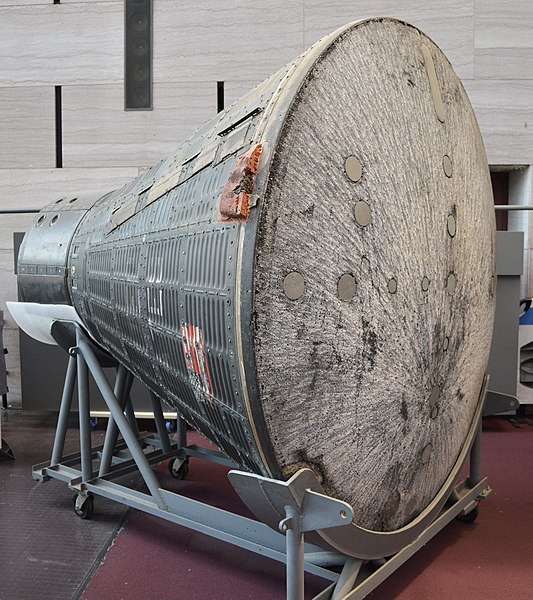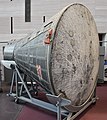File:Gemini Spacecraft – ‘Gemini IV’ (51102281900).jpg

Original file (3,766 × 4,238 pixels, file size: 9.17 MB, MIME type: image/jpeg)
Captions
Captions
Summary[edit]
| DescriptionGemini Spacecraft – ‘Gemini IV’ (51102281900).jpg |
This is the capsule from the Gemini IV mission, which saw Ed White become the first American to carry out a space-walk. The complete mission lasted four days, from 3rd to 7th June 1965 and orbited the Earth sixty-six times. The Command Pilot was James McDivitt, who later commanded Apollo 9. Sadly, Ed White was one of three Astronauts who died in the Apollo 1 fire on 27th January 1967, along with ‘Gus’ Grissom and Roger Chaffee. The Gemini IV capsule was built by McDonnell and was launched by a Titan II rocket built by Martin. Officially designated the Gemini SC4, the spacecraft was to have been named “American Eagle” by its crew, but the naming of spacecraft was temporarily banned by NASA before the launch so the crew wore ‘Stars and Stripes’ insignia on their spacesuits instead, the first astronauts to do so. This historic capsule is seen on display in the ‘Boeing Milestones of Flight Hall’ (Gallery 100/200). National Air and Space Museum, Washington DC. 11th May 2015 14th March 2018 The following information is from the museum website:- “On June 3, 1965, a Titan II rocket launched this spacecraft, Gemini IV, carrying astronauts James McDivitt and Edward White into orbit. The flight lasted four days and included a historic space walk by White, the first by an American, early in the mission. Ten weeks earlier, Soviet cosmonaut Alexei Leonov had become the first human to "walk in space." NASA broadcast the audio from White's 22-minute "extra-vehicular activity" (EVA) live; he enormously enjoyed the experience. The flight plan also included a rendezvous with the discarded second stage of the Titan II rocket. It was aborted, however, after pilot Jim McDivitt experienced unexpected difficulties reaching the booster because he had not been properly trained in rendezvous techniques. Other experiments during this flight included Earth photography, space radiation measurements, and medical effects of prolonged weightlessness. In 1967 NASA transferred the spacecraft to the Smithsonian.” |
| Date | |
| Source | Gemini Spacecraft – ‘Gemini IV’ |
| Author | Alan Wilson from Peterborough, Cambs, UK |
| Camera location | 38° 53′ 17.31″ N, 77° 01′ 11.41″ W | View this and other nearby images on: OpenStreetMap |
|---|
Licensing[edit]
- You are free:
- to share – to copy, distribute and transmit the work
- to remix – to adapt the work
- Under the following conditions:
- attribution – You must give appropriate credit, provide a link to the license, and indicate if changes were made. You may do so in any reasonable manner, but not in any way that suggests the licensor endorses you or your use.
- share alike – If you remix, transform, or build upon the material, you must distribute your contributions under the same or compatible license as the original.
| This image was originally posted to Flickr by HawkeyeUK at https://flickr.com/photos/65001151@N03/51102281900. It was reviewed on 8 May 2021 by FlickreviewR 2 and was confirmed to be licensed under the terms of the cc-by-sa-2.0. |
8 May 2021
File history
Click on a date/time to view the file as it appeared at that time.
| Date/Time | Thumbnail | Dimensions | User | Comment | |
|---|---|---|---|---|---|
| current | 11:58, 8 May 2021 |  | 3,766 × 4,238 (9.17 MB) | Sentinel user (talk | contribs) | Transferred from Flickr via #flickr2commons |
You cannot overwrite this file.
File usage on Commons
There are no pages that use this file.
Metadata
This file contains additional information such as Exif metadata which may have been added by the digital camera, scanner, or software program used to create or digitize it. If the file has been modified from its original state, some details such as the timestamp may not fully reflect those of the original file. The timestamp is only as accurate as the clock in the camera, and it may be completely wrong.
| Camera manufacturer | NIKON CORPORATION |
|---|---|
| Camera model | NIKON D3200 |
| Exposure time | 1/20 sec (0.05) |
| F-number | f/3.5 |
| ISO speed rating | 200 |
| Date and time of data generation | 12:40, 11 May 2015 |
| Lens focal length | 18 mm |
| Width | 4,000 px |
| Height | 6,016 px |
| Bits per component |
|
| Pixel composition | RGB |
| Orientation | Normal |
| Number of components | 3 |
| Horizontal resolution | 300 dpi |
| Vertical resolution | 300 dpi |
| Software used | Adobe Photoshop Elements 14.0 (Windows) |
| File change date and time | 07:42, 6 April 2021 |
| Y and C positioning | Co-sited |
| Exposure Program | Normal program |
| Exif version | 2.3 |
| Date and time of digitizing | 12:40, 11 May 2015 |
| Meaning of each component |
|
| Image compression mode | 4 |
| APEX shutter speed | 4.321928 |
| APEX aperture | 3.61471 |
| APEX exposure bias | 0 |
| Maximum land aperture | 3.6 APEX (f/3.48) |
| Metering mode | Center weighted average |
| Light source | Unknown |
| Flash | Flash did not fire |
| DateTime subseconds | 70 |
| DateTimeOriginal subseconds | 70 |
| DateTimeDigitized subseconds | 70 |
| Supported Flashpix version | 1 |
| Color space | sRGB |
| Sensing method | One-chip color area sensor |
| File source | Digital still camera |
| Scene type | A directly photographed image |
| Custom image processing | Normal process |
| Exposure mode | Auto exposure |
| White balance | Auto white balance |
| Digital zoom ratio | 1 |
| Focal length in 35 mm film | 27 mm |
| Scene capture type | Standard |
| Scene control | None |
| Contrast | Normal |
| Saturation | Normal |
| Sharpness | Normal |
| Subject distance range | Unknown |
| GPS tag version | 2.3.0.0 |
| Serial number of camera | 2219062 |
| Date metadata was last modified | 08:42, 6 April 2021 |
| Unique ID of original document | B274D2BC9057B83446AB55BC4421C8B4 |
| IIM version | 9,933 |